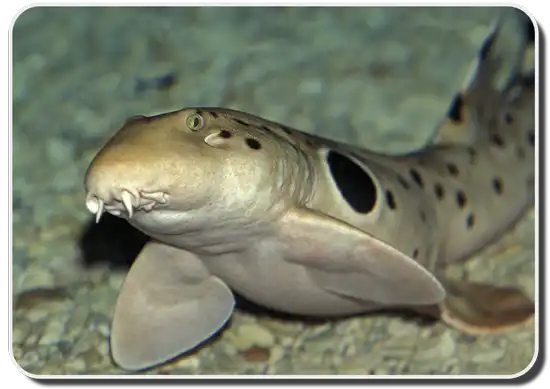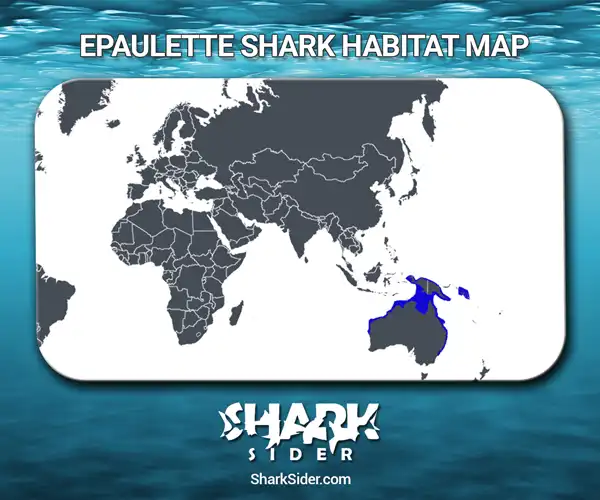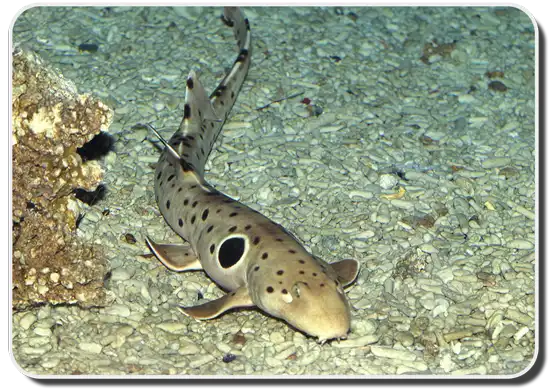Epaulette sharks are a species of bamboo shark, easily recognizable from the black eyespots behind their pectoral fins. These spots also give the shark its name, resembling military Epaulettes.
These sharks can “walk” with the help of their fins and can stay out of the water for extended periods.

Epaulette Shark Scientific Classification |
|
| Kingdom | Animalia |
| Phylum | Chordata |
| Class | Chondrichthyes |
| Order | Orectolobiformes |
| Family | Hemiscylliidae |
| Genus | Hemiscyllium |
| Scientific Name | H. ocellatum |
Description
These sharks are 27.5–35.5 in, with the maximum length reported being 42 in. They have an elongated body, with a groove connecting the short, round snout to the nose area. The nares also have a set of barbels. Inside their mouth, one can see several rows of small triangular teeth – 26–35 in the upper jaw and 21–32 in the lower one.
They have well-muscled pectoral and pelvic fins and a set of similar dorsal fins on their backs. The anal fin is present right before the almost horizontally placed caudal fin. The caudal peduncle is over half the shark’s body.
The most striking feature of these sharks is the presence of a black eyespot behind each pectoral fin. Their overall bodies are beige to brown and covered with scattered darker bands and brown spots.
Where do they live
Map Of The Epaulette Shark’s Habitat

The Epaulette shark lives over a relatively small range in the Indo-Pacific Ocean from the southern coast of New Guinea to the northern coast of Australia. Possibly the largest population of these sharks can be observed between the Capricorn and Bunker reefs of the Great Barrier Reef, with around a thousand of these sharks found around Heron Island alone.
These sharks live in places with shallow waters like coral flats and tidal pools, only reaching a maximum depth of 50 m. The waters sometimes are only deep enough to cover the shark.
Behavior
Dietary
Their diet consists of worms, bony fish, and crustaceans. Juveniles prefer worms, while adult sharks will eat crabs and shrimp.
Unlike other sharks, they chew their food for 5-10 minutes before swallowing.
Predatory
Epaulette sharks hunt at dawn and dusk with the help of their olfactory and electro-receptive senses. They expand their buccal cavity to suck their prey into their mouths and expel any debris accidentally consumed through their nostrils.

Reproductive
The mating period of these sharks is from July to December. Females initiate courtship by biting their preferred mate, after which the male will bite onto their pectoral fins to hold onto them while copulating.
As an oviparous species, the female lays 20-50 eggs annually. After four months, the young emerge from the eggs and can take care of themselves. Juveniles reach sexual maturity at around seven years when they are 21.5–25 inches long. These sharks can live up to 20-25 years.
Adaptations
The Epaulette shark can move about on their pectoral fins in a gait similar to walking. This movement is not limited to the ocean bottom but also the shore. The shark uses this ability to walk between separate bodies of water, letting them find suitable places where predators won’t hunt them.
However, as they need to stay out of the water, they have evolved to survive up to three hours at low or without oxygen – a condition called hypoxia. Unlike other creatures that suffer from lowered blood levels and heightened glucose requirements, these remain constant in this shark.

Interactions with humans
Epaulette sharks are incredibly docile and don’t mind the presence of humans. They can be kept in captivity without any issue; however, they need to be kept on their own as they will feed on any other fish in the same community tank. The size of these tanks can be around 135 gallons, but its preferable to house full-grown specimens in 180 gallon tanks.
For the 40th anniversary of the movie Jaws, the BBC produced a documentary series called Shark in 2015, with the first episode focusing on the Epaulette shark and its behavior.
As per the IUCN, the Epaulette shark is “Least Concern” or “LC”.
